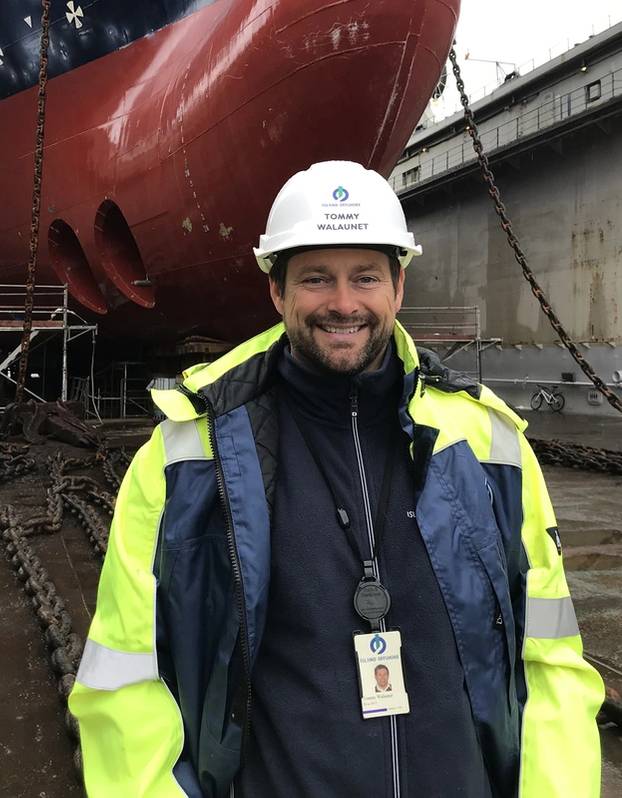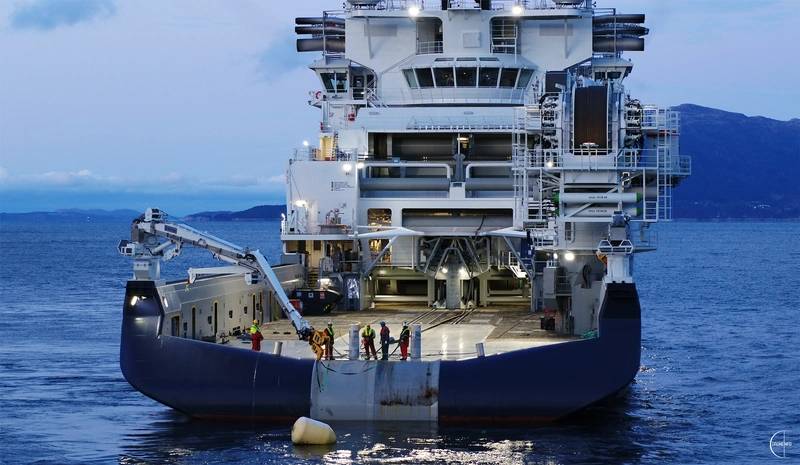

While facing the same challenging market conditions as offshore vessel owners and service companies worldwide, Norway’s Island Offshore recently broke free from the enforced conservatism of the E&P sector, by adding not just a new ship to its fleet, but one that re-writes the rulebook in capabilities, technology and despite its size and power, environmental credentials.
Simply put, Island Offshore’s new deep water installation Vessel ‘Island Victory’ is the most powerful multi-purpose offshore vessel ever built; a point proven during bollard pull tests conducted by its builder VARD last November with a towing power of 477 tonnes recorded, smashing the existing record of 423 tonnes.
Such tests could be viewed as at least an irrelevance, when the world faces the effects of man-made climate change, but Tommy Walaunet, Managing Director at Island Offshore is quick to point out that Island Victory’s extreme power and combination of capabilities will help clients to reduce the environmental impact of their deep water operations.
“Island Victory’s brute strength enables heavy duty, deep water mooring using a single vessel, when before, two or three would be needed to carry the loads and achieve the same outcome,” explains Mr. Walaunet. “We need the power and deck space for mooring operations and transport of wires and chains, but when compared to using multiple vessels for the same job, Island Victory can do it using less fuel and with lower emissions.”
A true multi-purpose behemoth, with a length of 123 metres and breadth of 25 metres, Island Victory boasts a 250-tonne offshore crane, accommodation and diverse client facilities for 110 people, and a working deck measuring 1200 m2. The market already seems to be taken by its extreme capabilities. Delivered to Island Offshore on February 7th this year, she started work immediately and is booked solid through to November already.
“We see a lot of interesting projects for Island Victory, but we are well aware that it’s not a spot vessel in the traditional sense,” says Mr Walaunet. “While perfectly capable, its scale and power could be excessive for standard anchor handling work, but there are a lot of interesting projects involving FPSOs and offshore wind farms internationally in the next few years and this is where we see some great opportunities.”
Environmental progress
Island Victory is designed to offer a means to achieve more efficient deep water operations by being capable of doing jobs usually performed by multiple vessels, but Island Offshore is well aware of the challenges ahead for its whole fleet as regulations continue to pressurize the industry to reduce its environmental impact across the board.
“Environmental requirements, especially over the last year have come on really strong, both commercially and politically,” says Mr. Walaunet. “It’s a challenge for us all today and will be for decades to come, despite progress the industry has already made in the last 10 years to reduce fuel consumption and emissions.”
Taking the measures needed to further cut greenhouse gas and CO2 requires ring-fenced Capex funding, which in a general downturn is not always easy to secure. According to Mr Walaunet however, while the sector might have been a bit behind on investment, more funds are becoming available.
“We’ve done a lot over the years to reduce fuel usage. Working on hull designs, ship designs, optimizing machinery and configuration of vessels has all provided environmental and financial efficiencies. We’re now investing in and deploying hybrid solutions using battery packages and digital technology to optimize our operations. For most vessels we see tangible savings not just on fuel use, but also through reducing machine hours and therefore the cost of maintenance.” “We’ve done a lot over the years to reduce fuel usage. Working on hull designs, ship designs, optimizing machinery and configuration of vessels has all provided environmental and financial efficiencies. We’re now investing in and deploying hybrid solutions using battery packages and digital technology to optimize our operations. For most vessels we see tangible savings not just on fuel use, but also through reducing machine hours and therefore the cost of maintenance.” Tommy Walaunet, Island OffshoreDiversity delivers sustainability
“We’ve done a lot over the years to reduce fuel usage. Working on hull designs, ship designs, optimizing machinery and configuration of vessels has all provided environmental and financial efficiencies. We’re now investing in and deploying hybrid solutions using battery packages and digital technology to optimize our operations. For most vessels we see tangible savings not just on fuel use, but also through reducing machine hours and therefore the cost of maintenance.” Tommy Walaunet, Island OffshoreDiversity delivers sustainability
Island Victory joined the Island Offshore fleet as a three-year company restructuring plan enters its final phases and Mr Walaunet is confident that the decision to invest in such an extensive undertaking was the right one. “As a privately-owned company we are fortunate to have investors with an understanding of, and appetite for risk,” he explains. “This gives us the ability to identify and drive new opportunities with concepts that bring something new to the market. It’s a key strength especially when a general market downturn has forced restructuring throughout the industry.”
The early stages of Island Offshore’s own restructuring saw the sale of two smaller Platform Supply Vessels, but 46-year-old Mr. Walaunet, who became Island Offshore’s MD in September last year after starting at the company in 2007, believes the 28-strong fleet is well placed for the future.
“The diversity in our fleet is a strength for us. We can’t rely on all segments being profitable at the same time, so by offering a spread of vessel types we can reduce our market exposure and ensure we have the right capabilities for our clients when they are needed.”
Developing opportunities
Island Offshore’s fleet is made up of three mooring and installation, three light well intervention, three subsea support, three well stimulation and 12 platform supply vessels. It’s completed by four walk-to-work (W2W) vessels, an important part of the business that has grown considerably for Island Offshore in recent years.
“We saw that the market was satisfied with standard OSV and PSV tonnage and we were looking for niches where we could add value to our vessels and find work outside of the extremely competitive OSV market. We converted the first vessel to W2W in 2013 by adding a special crane and gangway, in addition to accommodation and a helideck.”
The investment has delivered an impressive track record in the growing W2W sector and has so far led to three further vessel conversions. Island Offshore now has two W2W vessels working for offshore wind clients and two operating on oil & gas projects. While offshore wind vessels have developed in line with market growth, part of the decision to produce W2W vessels for oil & gas was based on a less immediate, but potentially significant need.
“We are really combining different uses for the oil companies. Our newest W2W vessel, Island Clipper retains most of its original PSV capacities, but we have expanded its capabilities with a flexible gangway that can be mobilised within 48 hours, making it an ideal solution for maintenance on unmanned installations – the number of which is growing in the North Sea. Looking ahead the safe passage and transfer these vessels provide could be a real alternative to helicopters for some projects.”
Navigating a recovery
The introduction of Island Victory and Island Clipper shows that something is being done right at Island Offshore’s HQ in the well-known offshore industry town of Ulsteinvik on Norway’s west coast. And while the eagerly awaited ‘recovery’ or signs of a new offshore boom are certainly not on the near horizon, forward thinking fleet diversification is seeing some players return to a semblance of stability.
For Mr. Walaunet and Island Offshore, navigating the financial challenges of recent years and the environmental challenges ahead means taking calculated risks based on experience and an understanding of the industry. It helps when everybody is on the same page.
“Having owners that are very industrial with a lot of knowledge about vessels and industry needs allows us to identify opportunities outside of standard tonnage. I believe it’s this that has enabled us to hit all of our restructuring targets and provide the new capabilities of Island Victory for complex deep-water projects that are contributing to re-shaping the offshore industry.” Photos: Island Offshore/DroneinfoShip Name Island Victory
Photos: Island Offshore/DroneinfoShip Name Island Victory
Owner Island Offshore Management AS
Type Deep Water Installation / Anchor handling – DP II
Design Kongsberg Maritime UT 797 CX
Ship Builder Vard
Material Steel
Delivery February 2020
Length, (o.a.) 123.4 m
Length, (b.p.) 112 m
Breadth, (molded )25 m
Depth, (molded) 10 m
Draft, (designed) 8 m
Draft, (scantling) 8 m
DWT (at design draft) 5899
DWT (at scantling draft) 6264
Speed max 18,75 knots
Fuel Type Fuel oil
Main engines 2x RR Bergen B32:40V16PCD 8000kW each + 4 RR Bergen C25:33 L9 2880 kW each + 2 x MTU 16V4000M34 1999 kw each
Total installed power 42,880 HP
Bow Thrusters
2x RR TT2650 DPN CP 1600kW each | 1x RR Azimut Swing up TCNS092/62-220 2000kW - stern 2 x RR 2400 DPN 1200 kW
Propellers 2 x RR CPP 1
Bearings Wartsila/Cedervall
Gears Scana Volda
Generators 4 x Marelli MJRM LB8 (gen set)
Engine controls Kongsberg RR Bergen
Radars Furuno
Depth Sounders Furuno
Auto Pilot Marine Technology
Radios Sailor
AIS Furuno
GPS Furuno
GMDSS Sailor
SatCom Marlink
Mooring equipment Konsgberg winches
Fire extinguishing systems Danfoss Semco
Fire detection system Consilium
Heat exchangers Alfa Laval Nordic
Lifeboats Harding Safety/Palfinger Marine
Liferafts Viking Safety Equipment
Coatings Akzo Nobel
BWMS Optimarin
Class DNV+1A1, Offshore Service Vessel+ AHTS, SPS, NAUTT-OSV (A), ICE 1A*, EO, DYNPOS AUTR, CLEAN DESIGN, DEICE, COMF-V(3), T-MON, BIS, DK(+), HL (p) OILREC, LFL*, COMF-C(3)
Cargo deck area1,200 sq. m.
Rig chain lockers (7 lockers) 2,765 cu. m.
Rig chain lockers incl. moon pool locker s2,200 cu. m.
Moon pool capacitymax 800 T
Accommodation 110
Bollard Pull 477 T
Moon pool8.0 x 7.2 m. (526 m3)
Work ROVs
2x Fully integrated WROV and LARS system permanently installed on board, for depths up to 4000 meter (1side/1moonpool)
1x Offshore AHC crane
250t/17m-20t/40m- wire length 3000m
1x Deck crane6t/20m- 12t/10m
2x Cargo rail cranes
PS RR Capacity 2,8t/3,2m- 15,4m outreach 15t/3m / -SB RR Capacity 2,8t/3,2m- 15,4m outreach 15t/3m



